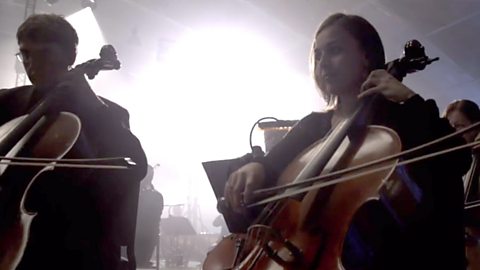In the Hall of the Mountain King by Edvard Grieg

Dan Starkey introduces Grieg's In the Hall of the Mountain King
Grieg's music is brought to life with a mysterious animated introduction.
Grieg's music drew on the Norwegian folk tunes of his homeland. He wrote many songs and piano miniatures. He was a leading composer of the Romantic era and brought the music of Norway to an international audience.
Grieg's 'Peer Gynt Suite' tells the story of a young boy – Peer Gynt, who falls in love with a girl but is not allowed to marry her. He runs away into the mountains but is captured by trolls who take him to their King. Peer Gynt tries to escape but is chased by the trolls and runs into the troll King but eventually gets away.
Listen out for: The strings that play the sounds of Peer tiptoeing and running to escape. The tiptoeing sound is an effect called pizzicato where string players pluck the strings of their instrument rather than use a bow.
Watch the introduction film at the top of the page then starting exploring the music:
Watch the full orchestral performance
Watch the full performance of In the Hall of the Mountain King, played by the 大象传媒 National Orchestra of Wales and conducted by Thomas Søndergård:
MP3s: Listen to the music or download the audio
Download the
You can also download the
Or download the
To save to your computer: PC - right-click and save, Mac - ctrl-click and save.
Lesson plans: Activities and exercises
Download classroom lesson plans to explore Grieg's music (available as PDFs).
To save to your computer: PC - right-click and save, Mac - ctrl-click and save.
- to accompany the
Suitable for:
- Key Stage 2 in England and Wales
- Second Level, P5-P7 in Scotland
- Key Stage 1/Key Stage 2 in Northern Ireland
Lesson plan 1 written by Ann Barkway. Lesson plan 2 written by Andrew Smith. Lesson plan 3 written by Rachel Leach.
Arrangements: Play the piece with simplified parts
All parts have been designed to work together to enable mixed-ability groups to perform together
Beginner/pre-Grade 1
- | | |
- | | |
- | |
- |
Grade 1-3
- |
- | | |
- | |
- |
Grade 4-5
- | | | |
- | | |
- | | | | | |
- | | |
- |
Combined score
Figurenotes
- |
- | | |
Figurenotes are graphic scores specifically designed to help those with learning support needs to read, play and perform music -
Arrangements: Background notes
From the arrangers:
Notes on pre-Grade 1 and Grade 1-3 parts (Written by from Andrew Smith)
All the beginner and Grade 1-3 arrangements are short excerpts of the work named in the title and complement the Grade 4-5 arrangements. This enables you to involve players of different abilities in one ensemble, all performing the same piece.
Where as the Grade 4-5 arrangements are around 3 minutes each, the beginner parts are between 60-90 secs, allowing for the stamina of a young musician who is used to playing pieces of similar duration.
The beginner and intermediate arrangements have been orchestrated for many different instruments, from flute to ukulele, however many different combinations of instruments can be used, even if your school has one or more that is not listen in the score!
The standard of playing for the beginner parts is based around the first few notes I'd expect the musician to learn, and basic semibreve, minim, crotchet, quaver rhythms. As much as possible, I have also tried to move to adjacent notes/strings, thus avoiding big leaps. The standard of playing for the intermediate parts is based around ABRSM Grade 1-3.
In most cases, the Grade 4-5 optional piano accompaniment parts will fill in any gaps, and will be useful for rehearsals or even in performance alongside an ensemble performing entire beginner and/or intermediate parts.
Notes on Grade 4-5 parts (Written by arranger Gareth Glyn)
All the arrangements present a short (3-minute) excerpt or abridgment of the work named in the title, and have been conceived in such a way that many different combinations of instruments can be successfully employed in playing them, even if your school hasn't got one or more of the instruments shown on the score.
The standard of playing necessary is about ABRSM Grades 4/5, though some parts may be marginally easier or trickier in places. Alternative notes have been provided for some more challenging situations.
In most cases, the optional piano accompaniment will fill any gaps, and may well be useful for rehearsals, though in most cases it would be best to do without it for performance, if possible.
Notes on orchestration
Below, in bold print, are the instruments named on the score, followed in bold print by other instruments which can play the same part.
Flutes - This line can also be played by violins. Because of the range of the flute, violinists attempting this line will find themselves playing in the higher positions. Violins also have their own dedicated part, so it's suggested that that part should have sufficient instruments on it before any are put on the flute line.
Oboes - Any mid-range C instruments (i.e. instruments which play the written pitch) can play from this stave. This would include violins, recorders and flutes (especially if there is a surplus, after having placed some on the dedicated flute line).
Clarinets in Bb - Other than soprano saxophones, which are highly unlikely to be found in a school orchestra, there are no obvious contenders to join the clarinets on this line. The writing, and the range, will generally be unsuitable for at-pitch Bb instruments such as the trumpet or cornet; and lower Bb instruments such as the euphonium shouldn't use this part as the sound will be muddied by the lower octave.
Bassoons - Cellos can play from this part (though in the first instance they should use their dedicated part).
Horns in F - This being a demanding instrument, rather rare in the school orchestra, it is generally doubled in the arrangements by the tenor horn in Eb, which has its own stave and part (see below).
Tenor Horns in Eb and alto saxophones - These play from the same part, which generally doubles the part of the F horn (see above). There is, if required, a part for 2nd Horn in F, which duplicates that of the Tenor Horn.
Trumpets in Bb - Their part can be played by cornets.
Trombones - The trombone part is available in two notations - bass clef at pitch and treble clef (brass band notation). The former part can also be used by cellos (though they have their own dedicated stave too); the latter by euphoniums and baritones (ditto).
Euphoniums and Baritones - Any spare trombones may be allotted this stave. A part in bass clef for this line is also provided; it's called '2nd trombone'.
Bass in Bb - The part for this instrument is also provided in bass clef, for the orchestral tuba. A separate part is provided for the smaller Eb bass; the music is identical in pitch, except for the odd occasion where an upwards octave transposition has been necessary.
Percussion - The name for this varies from piece to piece, but it is generally for any kind of large drum. If the part is called 'timpani', then of course those tuned drums should ideally be employed, but any percussive instrument will usually be quite effective. The percussion parts of all the pieces can be executed by one player, except for the Adams, which has a quick change in the middle; however, in this case, the instrument used at the start can just as well be used right through.
Violins - This part could be doubled by flutes or oboes if there are enough of them to go around. Players who aren't comfortable out of 1st position should consider an alternative (see below).
Violas - These aren't particularly prevalent in school orchestras, so a special violin part is provided. It's called 2nd violin, and is identical to the viola part except for passages which go below low G – these are either omitted in the special part or transposed upwards.
Cellos - Their part can be played by bassoons, though they should in the first instance be placed on their dedicated line.
Double Basses - Any other bass-clef C instrument (bassoons, cellos and the like) playing from this part will be doubling it an octave higher; this will do no harm at all, and often it would be better to have something on this line than nothing at all.
Watch the full performance

Full orchestral performance: In the Hall of the Mountain King from 'Peer Gynt'
Watch a full orchestral performance of Grieg's In the Hall of the Mountain King.
Additional resources
About the composer
EDVARD GRIEG

BORN: 1843 / DIED: 1907 / NATIONALITY: Norwegian
Grieg was a composer who firmly put his country, Norway, on the musical map. Many of his pieces were based on Norwegian fairy stories and melodies, and over 100 years since his death he is still his country's most respected composer. Grieg was taught piano by his mother from the age of just 6 and then when he was a teenager, a famous violinist spotted his talent and persuaded his parents to send him to music school in Germany, and so his music career began. In the Hall of the Mountain King comes from undoubtedly his most famous work - Peer Gynt, which was written in 1875 as background music to a famous play. The character of Peer Gynt is even older and has been a Norwegian folk tale for many centuries. Grieg took the best bits of his background music and made an orchestral suite which is very well known and made the Peer Gynt character recognisable around the world. Grieg also wrote a lot of piano pieces which describe simple stories, places and events. Some of these Lyric Pieces are quite easy to play and are often used in grade exams.











